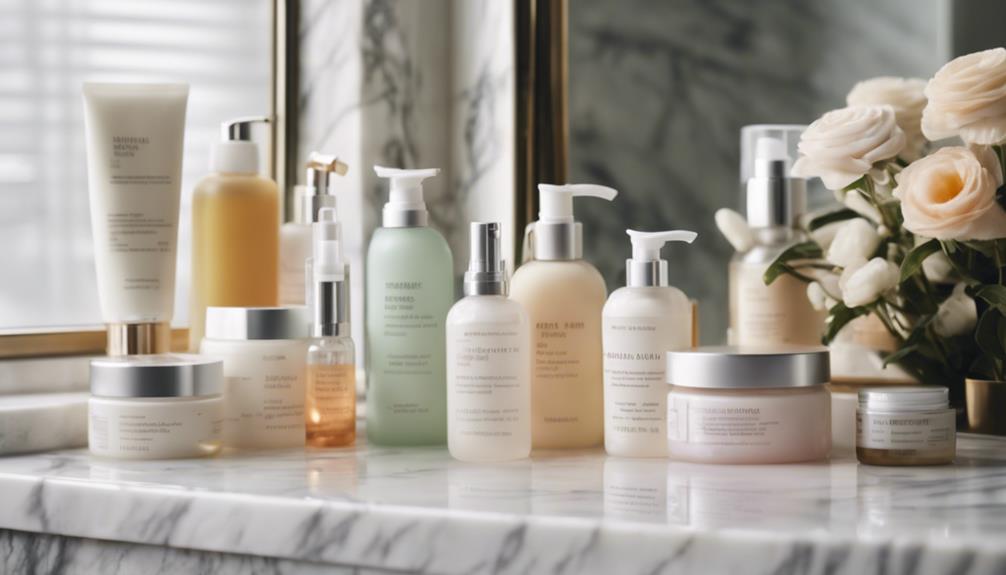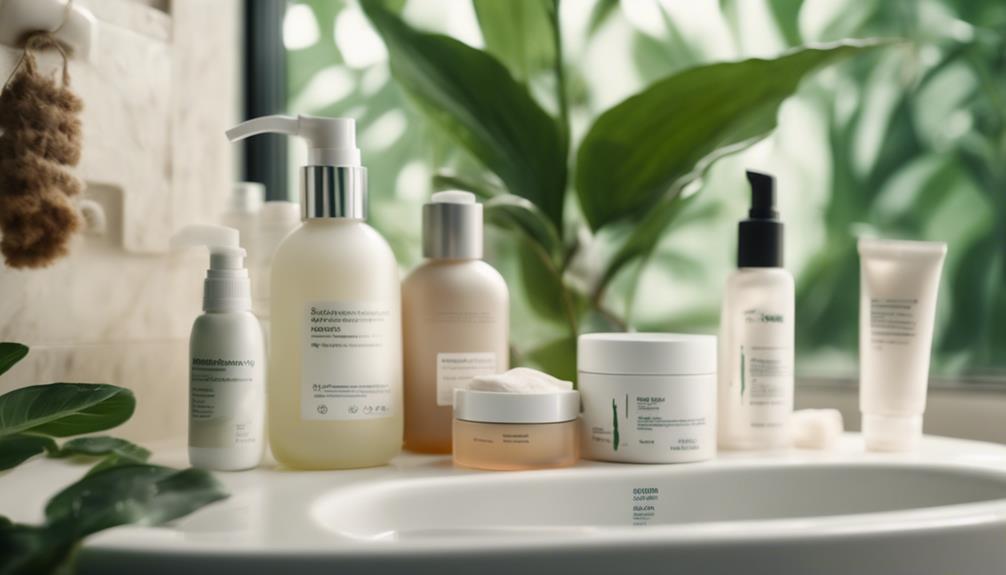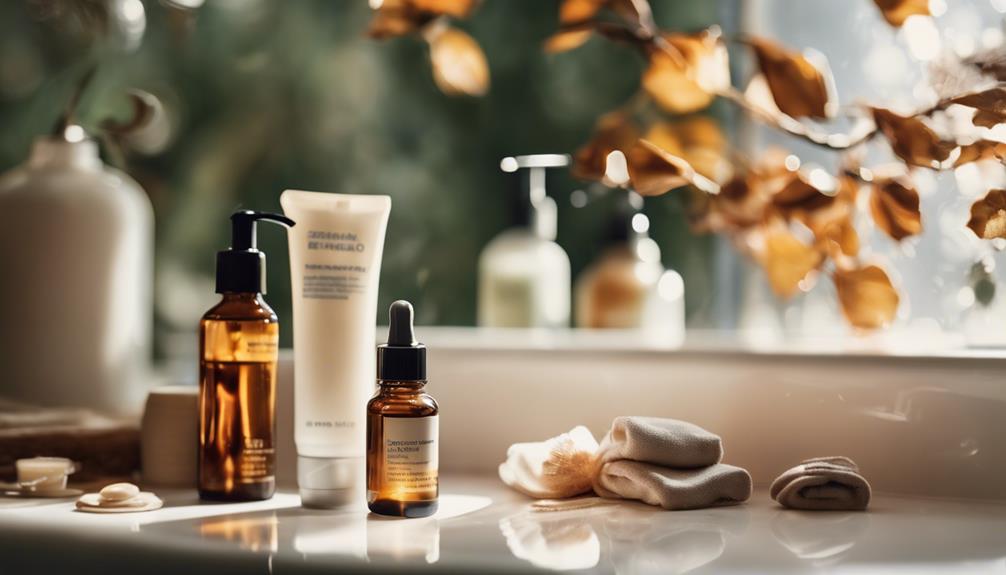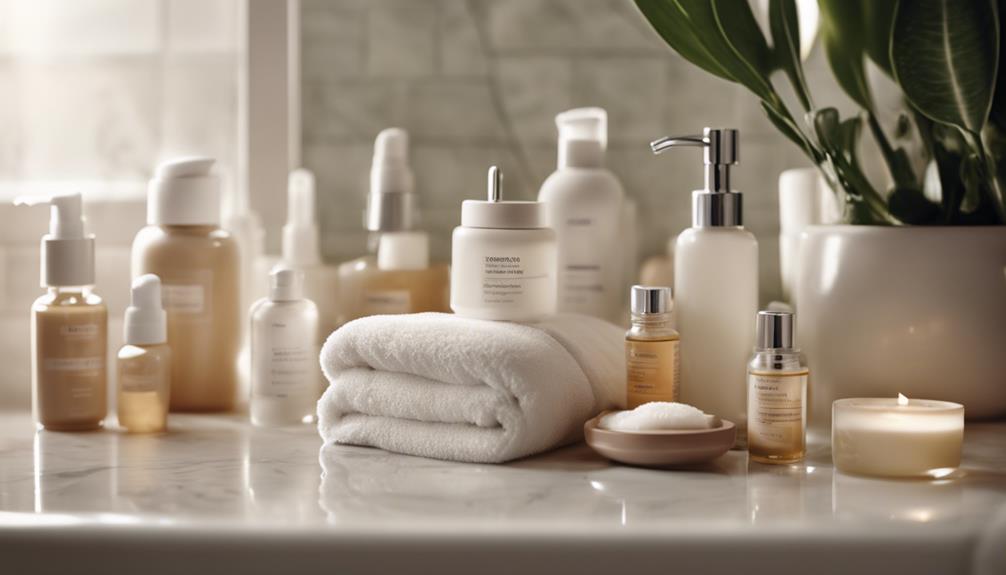To establish a custom skincare regimen, begin by identifying your skin type – oily, dry, combination, sensitive, or normal. Conduct a bare-faced test after cleansing and assess your skin after 30 minutes. Once you have determined your skin type, concentrate on the essential steps: cleansing, toning, and moisturizing. Select products tailored to your skin type; gel-based products are ideal for oily skin, while rich creams are suitable for dry skin. Remember to adapt your routine according to the seasons and avoid common mistakes such as over-exfoliation. There is still much to learn about perfecting your regimen to achieve radiant skin.
Key Takeaways
- Identify your skin type (oily, dry, combination, sensitive, normal) using the bare-faced test for effective product selection.
- Establish a consistent routine with three essential steps: cleansing, toning, and moisturizing tailored to your skin type.
- Choose products based on your skin type; opt for gel-based for oily skin and creamy formulations for dry skin.
- Adjust your routine seasonally; use lightweight products in summer and switch to richer formulations in winter.
Identifying Your Skin Type
To accurately identify your skin type, try the 'bare-faced test' by washing your face and evaluating its condition after 30 minutes. This simple method helps you determine whether your skin feels oily, dry, or balanced. Knowing your skin type is vital for creating an effective skincare routine tailored to your needs.
There are five main skin types: oily, dry, combination, sensitive, and normal. If you have oily skin, you might notice enlarged pores and a shiny surface, while dry skin often feels tight or flaky. Combination skin features both oily and dry areas, typically showing an oily T-zone and dryness on the cheeks. Sensitive skin may react with redness or irritation to certain products.
Identifying your skin type can greatly benefit your skincare routine by allowing you to choose appropriate skincare ingredients and a moisturizer based on your specific needs. For instance, oily skin benefits from lightweight, oil-free moisturizers, while dry skin requires more hydrating, cream-based options.
Avoiding misdiagnosis is essential, as over 80% of people get it wrong, leading to ineffective or harmful skincare choices.
Essential Steps in Skincare Routine

Once you've identified your skin type, you can begin creating a skincare routine that includes three key steps: cleansing, toning, and moisturizing.
Start with cleansing, which removes dirt, oil, and impurities. Choose a cleanser that suits your skin type—gel cleansers work best for oily skin, while creamy cleansers are ideal for dry skin.
Next, incorporate toning into your routine. Toning helps balance your skin's pH levels and provides additional hydration. Select a toner that addresses your specific needs, such as sensitivity or excess oil.
Finally, don't skip moisturizing! This step is essential for locking in hydration. Your moisturizer should also reflect your skin type; opt for gel-based products if you have oily skin and rich creams if your skin is dry.
Consistency is important in maintaining an effective skincare routine. Stick to these three steps twice daily for the best results, as the benefits of a well-structured routine typically take at least six weeks to become noticeable.
Choosing the Right Products

Choosing the right products for your skincare routine hinges on understanding your skin type and specific concerns. Identifying whether your skin is oily, dry, combination, sensitive, or normal will guide your choices. For instance, gel-based products work best for oily skin, while creamy formulations suit dry skin.
Here's a quick reference table to help you choose:
| Skin Type | Recommended Product Type | Key Active Ingredients |
|---|---|---|
| Oily | Gel-based cleansers | Salicylic acid, Niacinamide |
| Dry | Creamy, hydrating cleansers | Hyaluronic acid, Glycerin |
| Combination | Balancing toners | Witch hazel, Jojoba oil |
| Sensitive | Fragrance-free products | Aloe Vera, Chamomile |
| Normal | Lightweight moisturizers | Vitamin E, Green tea extract |
When selecting products, prioritize non-comedogenic options if you have oily or acne-prone skin to prevent clogged pores. Always conduct a patch test for new items, especially if you're prone to sensitivity. Tailoring your choices based on your skin type and concerns creates a personalized skincare routine that caters to your unique needs.
Adjusting for Seasonal Changes

Understanding your skin type is just the beginning; adjusting your skincare routine for seasonal changes is vital to maintaining healthy skin year-round. Each season brings unique environmental factors that can affect your specific skin needs.
In summer, opt for lightweight products to prevent excess shine and clogged pores. The heat and humidity can exacerbate oily skin, so choose oil-free formulations.
As temperatures drop in winter, switch to richer, cream-based moisturizers that combat dryness and enhance moisture retention. Your skin loses hydration in colder weather, so this change is essential.
Spring often brings increased pollen, which can impact sensitive skin types. Consider allergy-friendly formulations to mitigate any irritation.
Fall is the perfect time to prep your skin for the harsher winter months. Introduce nourishing treatments like hydrating serums and facial oils to guarantee your skin stays moisturized.
Remember to regularly reassess your skincare routine every season. By making these adjustments, you'll keep your skin healthy, hydrated, and ready to face whatever the weather throws your way. Embrace the changes, and your skin will thank you!
Avoiding Common Skincare Mistakes

Avoiding common skincare mistakes is essential for achieving and maintaining healthy skin.
One major mistake you might make is over-exfoliating. This can irritate your skin and damage its protective barrier, so limit exfoliating to once or twice a week based on your skin type.
Another critical error is ignoring sunscreen. Daily application of a broad-spectrum SPF 30 or higher is crucial for preventing UV damage and premature aging.
You should also be cautious with active ingredients. Using too many at once can lead to irritation, so introduce new products gradually and pay attention to your skin's response.
Don't forget to include your neck and décolletage in your routine; neglecting these areas can result in uneven skin tone and texture.
Lastly, always perform a patch test before fully applying new products. This helps you identify any adverse reactions by applying a small amount on a discreet area first.
Can Personalized Tips for My Skin Type Be Applied in a Step-by-Step Skincare Routine?
Yes, personalized tips for your skin type can be applied in a skincare routine stepbystep. By identifying your specific skin needs and selecting suitable products, you can tailor your routine accordingly. Following a customized step-by-step approach can help address your skin concerns effectively.
Conclusion
Building a skincare routine might seem overwhelming, but it's all about finding what works for you.
Remember, it doesn't have to be complicated or time-consuming; even a simple regimen can yield great results.
Don't worry if you don't see immediate changes—consistent care is key.
Embrace your unique skin journey, and enjoy the process of discovering what makes your skin glow.
You deserve to feel confident and beautiful in your skin, so start today!









